The Brahma Kamal plant is rare and classified as a rare plant species. Brahma Kamal, whose scientific name is saussurea obvallata, is a flowering plant in the Asteraceae family. It is a rare plant with attractive large flowers, found mainly in the Himalayan region. The Brahma Kamal plant has great spiritual significance in India, and Vastu Shastra recommends specific rules for keeping this plant in your home garden. Brahma Kamalam has the characteristics of both cactus (requires little water, grows in dry places) and succulent (rounded leaves).
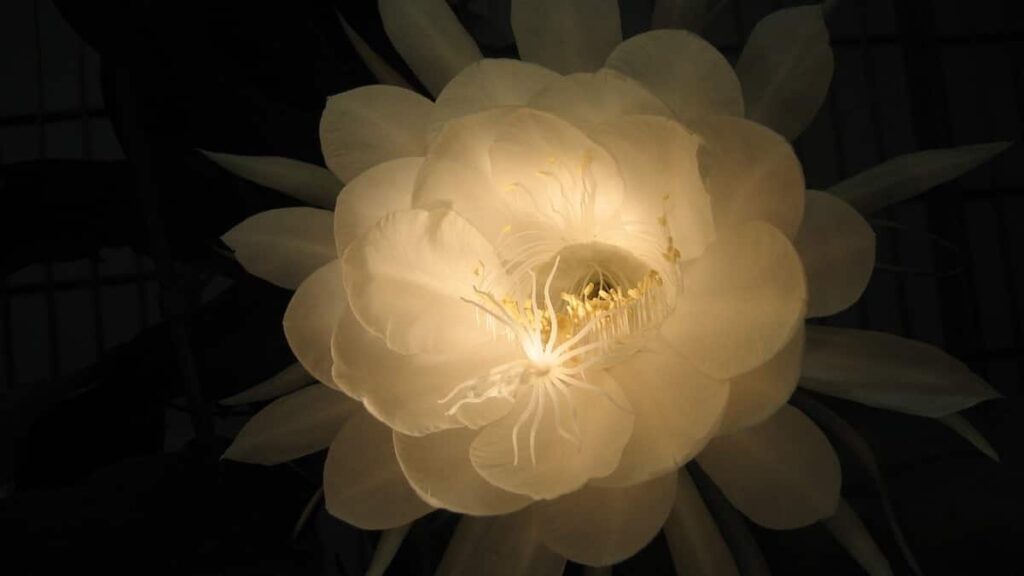
How to grow Brahma Kamal from cuttings
Brahma Kamal plant introduction
A small perennial herb is growing up to 60 cm in height. Stems are straight, ribbed, hollow, and usually purplish to reddish brown. Flowers with 2 to several discoid capitula, enclosed in terminal, creamy white or pale yellow involucriform bracts. The corolla is tubular with linear-lanceolate lobes, bluish-purple or violet. Cypselae are elongated or ovoid with white pips, pale creamy, brown, or grey.
The flowers grow on flattened stems, are nocturnal (blooming at night), and are fragrant. It is believed that the wishes of those who pray to God while the flowers bloom are fulfilled. This plant blooms rarely and only at night, and its flowers wither before dawn. However, it is sometimes referred to as the night-blooming cereus. It blooms from late spring to late summer. Large specimens can produce flowers in one season.
Location and sunlight for growing Brahma Kamal plant
The Brahma Kamal plant requires indirect and continuous sunlight. The leaves of the plant, which can also store water, will sunburnt due to direct sunlight. They will turn yellow. Avoid changing the place of the plant frequently. Once the sign of emergence is visible, do not repot the plant until the plant stops flowering. Otherwise, the bud will not open.
This plant is not tall and short. This flower will look like a small bush throughout its life. As we said earlier, it holds a sacred place in Hindu culture, so that means Brahma Kamal is very useful and needs extra care. It is also considered a type of cactus. If you plan to plant this flower, you must meet the strict water and light requirements.
In case you missed it: Garden Planting Calendar in India: Month-wise Chart and Guide for Fruits, Flowers, Herbs, and Vegetables
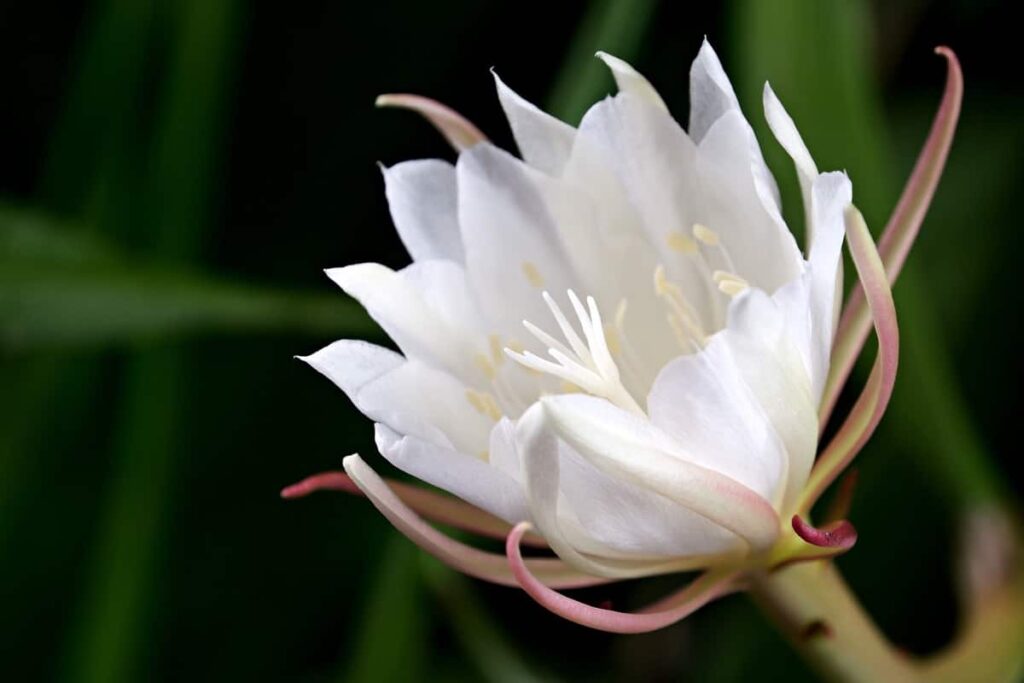
Temperature requirement for Brahma Kamal plant growth
Plants prefer a temperature range of 25 to 35°C. Plants thrive best in warm conditions. Do not place plants where there is strong heat or cold wind. They prefer normal humid conditions. Move plants indoors or in the shade in case of harsh winters or summers.
Special growing care for Brahma Kamal
Make sure to find a perfect place for the plant to grow. It is essential for plant growth. Do not overwater the plant. Avoid exposing them to extreme heat or cold. Do not mulch the soil. Avoid repotting plants, as they prefer to stay rooted. Do not prune the leaves. It is better if the leaves dry up and die in the plant.
As for soil selection, you will need very fertile, somewhat rocky soil. This selection aims to have as close a resemblance to the ground soil of the Himalayan mountains as possible. In this way, the ground will be able to retain most of its water for much longer.
Propagation of growing Brahma Kamal
- We can easily grow Brahma Kamal using its different plant parts like leaves and stems, i.e., vegetative propagation.
- Brahma Kamal plant is propagated by cuttings or layering of rhizomes, herbaceous stems, and leaf cutting or layering. A phylloclade can be placed in soil, rooted after about three weeks, and then planted in a pot.
- Large leaves can be cut into small parts, and these parts can be planted in the soil. Regular humidity should be maintained. These leaves form a full plant within two months of spreading. After two months, this small plant can be transplanted into a pot. During transplantation, we should uproot the plants with a ball of earth. This helps the flower to grow and adapt easily to the new location. Keep the plant in a shady place where there is no sunlight for a long time. This area should receive filtered sunlight. Choosing areas with about 1 hour of morning sunlight is better.
How to grow a Brahma Kamal plant from cuttings
Obtaining cuttings
The first and most important step is to obtain a leaf cutting from a healthy Brahma Kamal plant (you can get this from a nursery or gardener friend). The cutting length should be at least 10-12 cm. After obtaining the cutting, please place it in a dark place away from sunlight and allow it to form a callus (white protective layer). This protective layer will protect the plant from infection once it enters the growing medium. Once it is finished. Now you can proceed.
Preparation of potting soil
The Brahma Kamal plant is a cactus that requires very fast-draining soil for growth and does not tolerate much water to stay in the soil. You can use this potting mix for this or make your own using the following ingredients.
- Sand – 40%
- Coco peat – 25%
- Perlite – 10%
- Compost or Vermicompost – 25%
In case you missed it: Seed Sowing Chart in India: Schedule Guide and Calendar for Vegetables, Flowers, Herbs, and Fruits
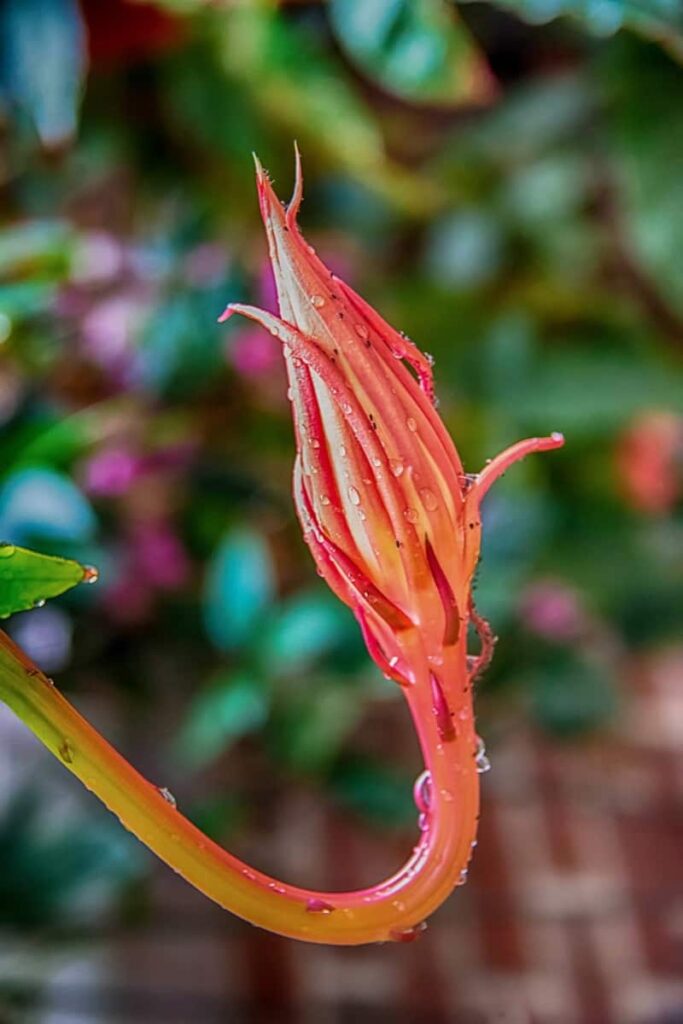
Planting cuttings
Fill potting soil into a 6-inch pot. Now, take the cutting, and put it 5-6 cm deep into the potting mix, so it doesn’t collapse. Next, moisten the soil by watering lightly with a pointed watering can. Be very careful to water directly on the soil, not the cuttings. Next, place the pot where it can receive low-to-medium indirect sunlight until it has grown; then, it can be moved to a brighter location.
Brahma Kamal Plant Care
- To care for the Brahma Kamal plant, it should be protected from direct sunlight, abundant watering, and repotting from time to time. In addition, it should be grown in potting soil with fast drainage.
- Brahma Kamal is easy to grow. You need to provide them with enough sunlight and nutrients. They need full sun exposure. You can use a garden or indoor pots. Make sure you feed your plant once every two weeks. Use a fertilizer that will promote growth. Water your plant regularly. Water your plant thoroughly until the soil is dry. They do not like to live in dark places.
- To grow Brahma Kamal indoors, you should use fluorescent lights. These lights give off more heat than normal bulbs. This means they can dry out your home if you leave them on for long periods. To avoid this problem, you should turn off your lights when you are not using them.
- Make sure you fertilize your plant once every two weeks. Use a fertilizer that will promote growth. Water your plant regularly. Water your plant thoroughly until the soil is dry. You can repot your plant every year. Repotting ensures that your plant gets all the nutrients it needs. If you notice that your plant looks sick, you should repot it immediately. Repotting prevents the spread of diseases.
- To prevent your Brahma Kamal from getting too much light, keep it in a shady spot. You can also feed your plants with organic matter. Organic matter provides vitamins and minerals to your Brahma Kamal.
| Sunlight | Full sun to part shade |
| Watering | Medium |
| Soil | Well-drained soil |
| Temperature | 25 to 35°C |
| Fertilizer | Apply any organic fertilizer |
Watering requirement for Brahma Kamal plant growth
Brahma Kamal is a succulent plant that can retain water in its leaves in dry conditions. This characteristic makes the leaves of the plant soft and flowery. Therefore, it is important to water when the top layer of soil becomes dry. You can tell if the growing soil is dry by touching the top surface. Avoid overwatering. The leaves will turn yellow and brown, which is a sign of root rot. Also, be sure to water directly on the soil rather than on the leaves of plants to avoid fungal growth.
This plant does not require much water for irrigation as it belongs to the dry Himalayan climate. So, we should irrigate only after the top layer of soil is dry. Or, apply direct irrigation every 2-3 days. If you don’t have time to irrigate every 2-3 days, you can add perlite to the soil mix to retain water longer. After adding perlite, we can irrigate it every 15-20 days. Too much water is bad. Overwatering causes root rot. So – proper drainage should be done.
In case you missed it: How to Start Rose Farming in the USA: A Step-by-Step Production Guide for Planting to Harvesting
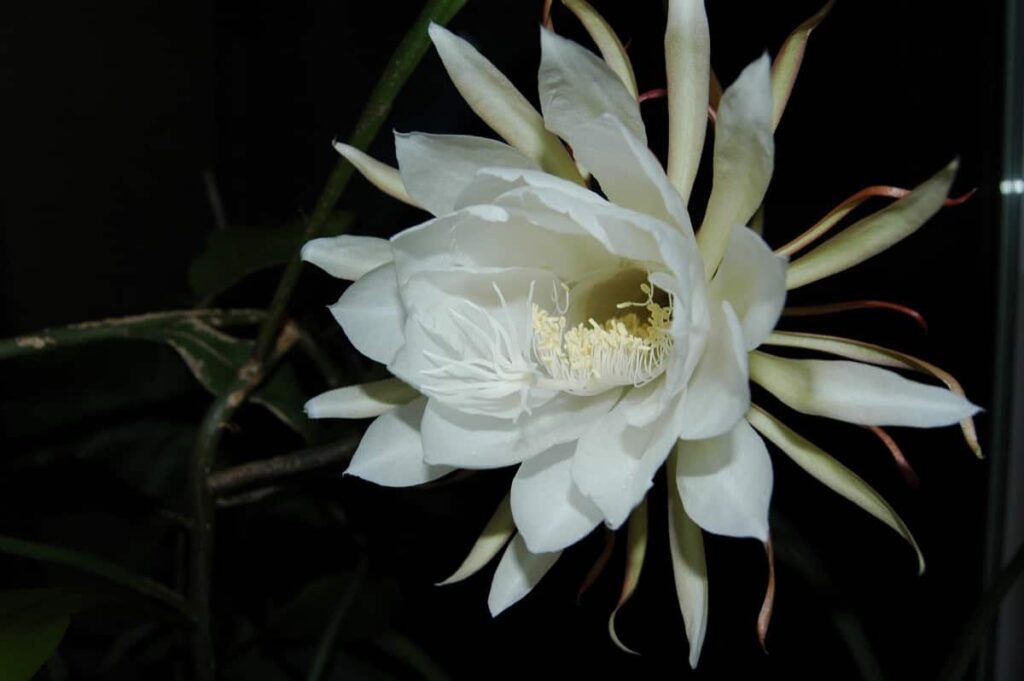
Brahma Kamal growing in pots
- Place the pot in a sunny place. After three days, move the pot to a shady spot. After a few weeks, when the cutting starts to sprout, you know it’s time to transplant it into a larger container or plastic pot.
- Press the soil into the pot and add additional soil (garden mix) if necessary. Keep the pot moist, and don’t overwater; it can kill your plant, so make sure the soil is dry between waterings.
- Ensure the plants get direct morning light (2-3 hours) for 10-15 days and don’t undergo immediate transplanting (at least 1 month). After that, you can remain the plant in the same pot for 6 to 7 months; later, you can transplant it in a slightly bigger pot than the present. If a branch of the plant is damaged in transit, prune it. New leaves will surely come.
Tips on how to grow Brahma Kamal
- Brahma Kamal usually grows with leaves that are thick and flat, and the leaves cover the stem.
- These plants grow long leaves. Therefore, it should be planted before winter as it adapts to cold weather.
- To grow this plant requires rough soil from the mountains because this soil retains less water.
- Brahma Kamal is a cactus variety, so it needs a lot of water and can be watered every two or three days. Do not add too much water.
- Water the Brahma Kamal plant regularly in summer. From spring to fall, water the plant every two weeks. Allow the soil to dry out slightly before watering the plant again.
- Use a trellis or moss pole as a structural support that the Brahma Kamal plant can climb on, encouraging the plant’s vertical growth.
- It would help if you had plenty of indirect sun and very fertile but rocky soil to grow this flower. We are not talking about the deeply packed soils of the lowlands but the coarse hill soils. The soil needs well-draining soil to retain as little water as possible.
- Brahma Kamal is a cactus type that does not require much water. It would help if you watered it once every two to three days unless you are in a dry spot. Never overwater this plant, as it will become waterlogged and die. This plant will never get too tall. It remains at bush height for years. Once it has reached its full height, you can make cuttings from it and plant it in separate pots.
Fertilizing management for growing Brahma Kamal
The plant needs a quality fertilizer high in phosphorus. This helps the plant to produce flowers. Fertilizer should be applied before and during the plant’s flowering season at an interval of 25 to 30 days. Stop using fertilizer after flowering stops. You should fertilize your Brahma Kamal once every month with manure. Applying fertilizer can help your plant produce new growth. This ensures that you have a healthy plant.
Pests and other problems for growing Brahma Kamal
They are not prone to many diseases and pests but overfeeding and overwatering can cause many problems. Overwatering the plant can weaken the leaves and cause the plant to become limp. Overwatering can cause freezing, which can lead to root rot. As a result, plants may wilt and die. Overfeeding the plants can cause the leaves to turn brown and dry. Too much sunlight or cold can also cause leaves to turn brown and wilt. In some cases, plants may be attacked by insects. To get rid of them, use a mild insecticide or spray the plants with neem oil.
In case you missed it: Marigold Seed Germination, Seed Rate, Planting
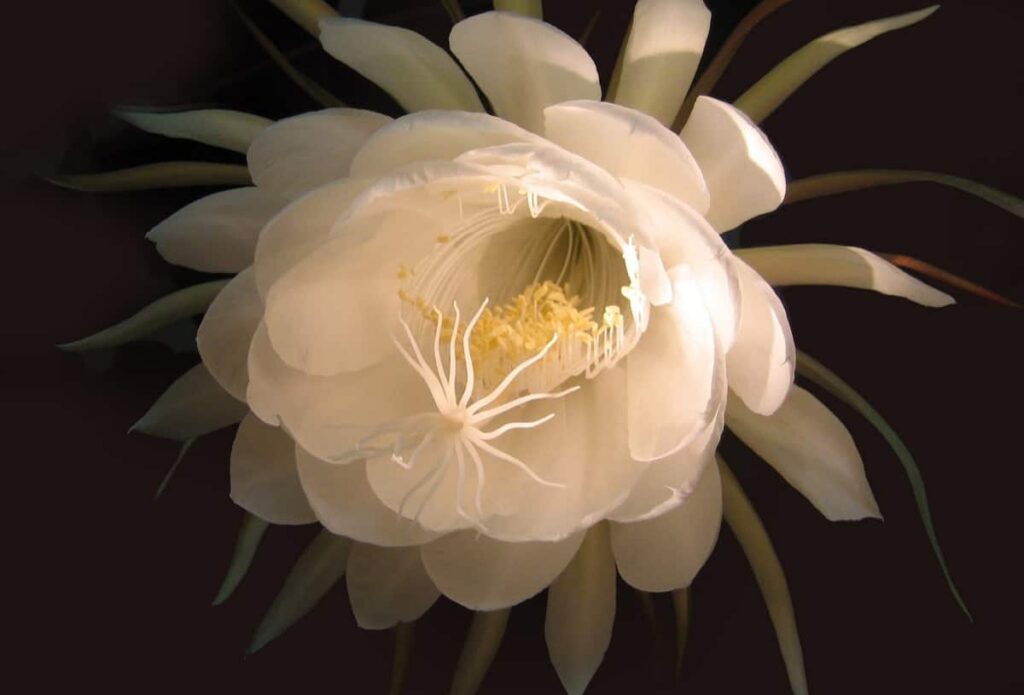
Leaves turn yellow – Because it stores water in its leaves, it needs much less water than other plants. For this, you should wait for the top layer of soil to dry before watering because if you water it too much. Its leaves will turn yellow and brown, which is an early sign of root rot.
Plant protection – Remove dead, infected, or damaged plant parts and throw them away from the plants. Generally, it is not affected by any pests or disease; in case of any infection, you can use neem oil spray as a basic treatment.
Frequently asked questions about Brahma Kamal (FAQ)
Can we plant Brahma Kamal at home?
Brahma Kamal is easy to grow at home and needs a good amount of sunlight but cannot tolerate direct sunlight. So, it should be placed where it can get bright but indirect sunlight throughout the day. However, if it is placed in direct sunlight, its water-storing leaves will soon start to sunburn.
Does the Brahma Kamal plant need sunlight?
It is propagated by cuttings or layering of rhizomes, herbaceous stems, and leaves. It prefers acidic soil and filtered sunlight.
How do Brahma Kamal flowers grow?
It usually comes from leaves that are thick and flat, and the leaves cover the stem. The plant is usually grown from cuttings. These plants are never tall. It should be planted before winter as it adapts to cold weather.
How long does Brahma Kamal take to grow?
Growing Brahma Kamal from leaf cuttings is a straightforward process. On the other hand, it takes forever (about five years) to grow it from seed. Nevertheless, home gardeners widely use the cutting method to grow this wonderful plant.
In case you missed it: Lily Flower Farming Info In Greenhouse
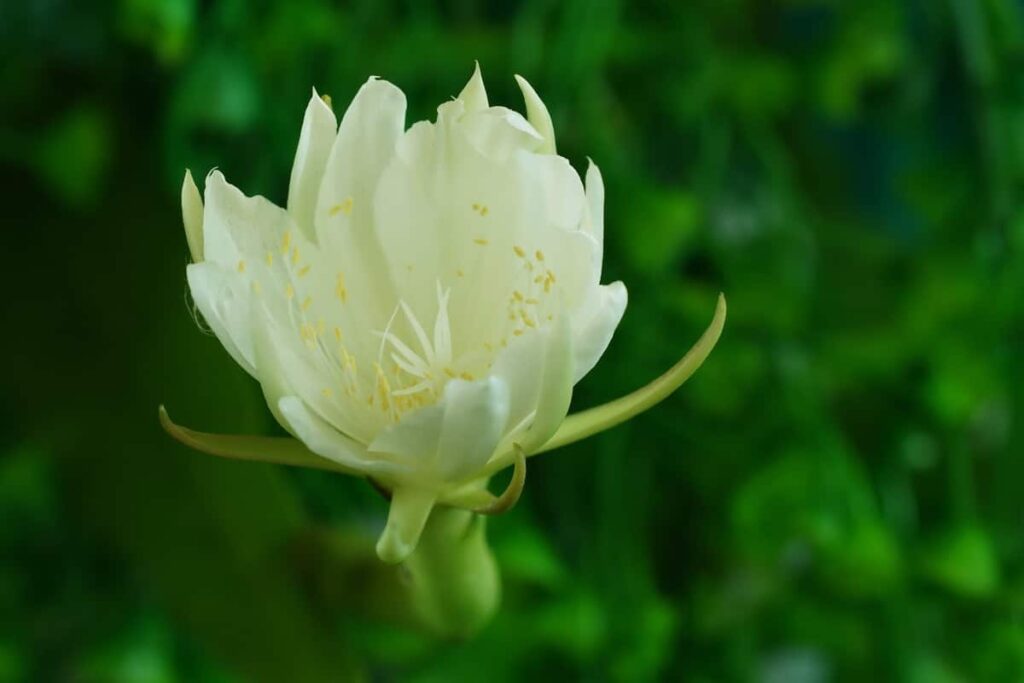
How can I grow Brahma Kamal fast?
To grow a Brahma Kamal plant, you take leaf cuttings and plant them in well-drained soil. Then, place this plant in a spot with indirect sunlight and water it if the top layer of soil is dry. This plant needs to be protected from direct sunlight and excess water.
Conclusion
This plant is also known as orchid cactus because the flowers are similar in beauty to orchid flowers. This plant needs constant sunlight. So, you have to be more careful while watering it. Brahma Kamal is a night-flowering variety of plants. Blooming begins in the late evening, and the flower reaches full bloom on or after 10 pm.
- How to Make Houseplants Bushy: Effective Tips and Ideas
- Innovative Strategies for Boosting Coconut Pollination and Yield
- Pollination Strategies for Maximum Pumpkin Yield
- The Complete Guide to Chicken Fattening: Strategies for Maximum Growth
- Natural Solutions for Tulip Problems: 100% Effective Remedies for Leaf and Bulb-Related Issues
- Revolutionizing Citrus Preservation: Towards a Healthier, Greener Future
- Natural Solutions for Peony Leaf and Flower Problems: 100% Effective Remedies
- Maximizing Profits with Avocado Contract Farming in India: A Comprehensive Guide
- Natural Solutions for Hydrangea Problems: 100% Effective Remedies for Leaf and Flowers
- The Ultimate Guide to Choosing the Perfect Foliage Friend: Bringing Life Indoors
- From Sunlight to Sustainability: 15 Ways to Use Solar Technology in Agriculture
- The Ultimate Guide to Dong Tao Chicken: Exploring from History to Raising
- The Eco-Friendly Makeover: How to Convert Your Unused Swimming Pool into a Fish Pond
- Mastering the Art of Delaware Chicken Farming: Essentials for Healthy Backyard Flocks
- 20 Best Homemade Fertilizers for Money Plant: DIY Recipes and Application Methods
- How to Craft a Comprehensive Free-Range Chicken Farming Business Plan
- Brighten Your Flock: Raising Easter Egger Chickens for Beauty and Bounty
- How to Optimize Your Poultry Egg Farm Business Plan with These Strategies
- Subsidy for Spirulina Cultivation: How Indian Government Schemes Encouraging Spirulina Farmers
- Ultimate Guide to Raising Dominique Chickens: Breeding, Feeding, Egg-Production, and Care
- Mastering the Art of Raising Jersey Giant Chickens: Care, Feeding, and More
- Ultimate Guide to Raising Legbar Chickens: Breeding, Farming Practices, Diet, Egg-Production
- How to Raise Welsummer Chickens: A Comprehensive Guide for Beginners
- How to Protect Indoor Plants in Winter: A Comprehensive Guide
- Ultimate Guide to Grow Bag Gardening: Tips, Tricks, and Planting Ideas for Urban Gardeners
- Guide to Lotus Cultivation: How to Propagate, Plant, Grow, Care, Cost, and Profit
- Agriculture Drone Subsidy Scheme: Government Kisan Subsidy, License, and How to Apply Online
- Ultimate Guide to Raising Araucana Chickens: Breed Profile, Farming Economics, Diet, and Care
- Bringing Hydroponics to Classroom: Importance, Benefits of Learning for School Students
- Ultimate Guide to Raising Polish Chickens: Breed Profile, Farming Economics, Diet, and Care
- Ultimate Guide to Raising Australorp Chickens: Profile, Farming Economics, Egg Production, Diet, and Care
- Silkie Chicken Farming: Raising Practices, Varieties, Egg Production, Diet, and Care
- Sussex Chicken Farming: Raising Practices, Varieties, Egg Production, Diet and Care
- Homemade Feed Formulations for Livestock: Discover Cost-effective Starter to Finisher Feed Recipes
- 20 Best Pig Weight Gain Supplements: Top Swine Weight Gain Formulas
- Ultimate Guide to Elderberry Farming: Propagation, Planting, Yield, Cost, and Profit